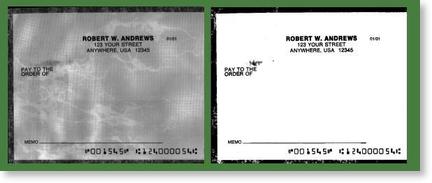I Need to Convert a Gray Image to Bitonal
Auto Binarize
Autobinarize automatically computes all necessary parameters by analyzing the input data before actually performing the binarization. The algorithm is tuned to typical document images, consisting of dark text on brighter background. It is robust to shadows, noise and background images.
Example of Autobinarize:
Binarize
Binarization works 1-bit, 8-bit and 24-bit input images creating 1-bit output of the same dimensions. Parameter options should be selected according to the type of image and desired results. This operation modifies the color palette associated with the image and sets it to two colors, with black as color 0 and white as color 1.
Local Contrast Enhancement
The LceFactor property increases the contrast in each region of the image. When used as a prelude to binarization it increases the sensitivity of the binarization to detail in all regions of the image.
Example of original image:
Example of local contrast enhancement:
Example of local contrast enhancement and binarization:
BinarizeBlur
The BinarizeBlur enumeration can be used with the LceFactor property when the original digitization is fine enough to reveal the halftone grid on the original document. It ensures that shades of gray are interpreted as such, rather than a combination of black and white. There are three options: Gaussian, Smart and none.
Example of an image binarized with local-contrast enhancement without pre-blur:
Example of image binarized with local-contrast enhancement with Gaussian pre-blur:






